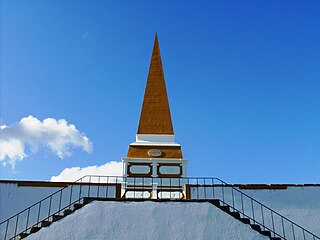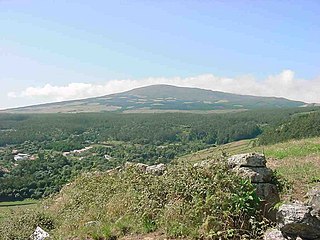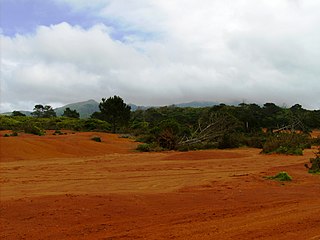
The following is a list of the prominent islets or volcanic stacks in the archipelago of the Azores:

The following is a list of the prominent islets or volcanic stacks in the archipelago of the Azores:

The Castle of Moinhos, officially known as the Castle of São Cristóvão, or Castle/Fort of São Luís is the name of the ruins of 16th-century fortification in city of Angra, on the Portuguese island of Terceira in the archipelago of the Azores. It is primarily known as the Castle of Moinhos, owing to the popular name given to the site for the number of mills that dotted the hilltop, on which the castle was erected.

The Cabras Islets or Cabras Islet is an uninhabited dual islet located along the southern coast of the island of Terceira in the Portuguese archipelago of the Azores. The group, with a total area of 29 hectares and perimeter of 3,239 metres (10,627 ft), is the largest islet in the Azores. Locals normally refer to it as a single islet, but it comprises two landforms: the Ilhéu Pequeno and the Ilhéu Grande.

The Lagoa do Negro is an ephemeral lake and humid zone located in the civil parish of Biscoitos, municipality of Praia da Vitória, on the island of Terceira, Portuguese archipelago of the Azores.

The Fort of Negrito is a 16th-century maritime fort situated in the civil parish of São Mateus da Calheta, in the municipality of Angra do Heroísmo on the island of Terceira, Azores, Portugal.

Fortress of São Mateus da Calheta is a fort in the civil parish of São Mateus da Calheta, in the municipality of Angra do Heroísmo, island of Terceira, in the Portuguese archipelago of the Azores.

Fort of São João, also known as Fort of Biscoitinho, is a medieval fort, in the civil parish of São Mateus da Calheta, in the municipality of Angra do Heroísmo, on the Portuguese archipelago of the Azores.

The Fort of Cinco Ribeiras, also known as the Fort of Nossa Senhora do Pilar or Fort of São Bartolomeu, ruins of a 16th-century fortification located in the municipality of Angra do Heroísmo, along the southeast coast of Terceira, Portuguese archipelago of the Azores.
The Fort of the Caninas, is a medieval fort situated in the Portugueses civil parish of Porto Judeu, municipality of Angra do Heroísmo, in the archipelago Azores.
Fort of the Cavalas is a fort situated in the civil parish of São Sebastião in the municipality of Angra do Heroísmo, in the Portuguese archipelago of the Azores.

The Nature Park of Terceira (Portuguese: Parque Natural de Terceira, or simply the Terceira Nature Park developed from the intention of better managing the protected areas of the island of Terceira, and was instituted by the "Secretaria Regional do Ambiente e do Mar", of the Autonomous Regional Government of the Azores. It includes an area of approximately 22% of the island classified under the International Union for Conservation of Nature's Nature Reserve designation.

The Fort of the Church São Mateus da Calheta, also referred to as the Forte da Igreja, are the coastal ruins of a 16th-century fort situated in the civil parishof São Mateus da Calheta, municipality of Angra do Heroísmo, on the Portuguese island of Terceira, in the archipelago of the Azores. It was destroyed, along with the church, in 1893 during a cyclone; while the church was eventually reconstructed some years later, the fort was abandoned and left to ruin.
A Captaincy-General of the Azores (1766—1832) was a politico-administrative structure of governance imposed in the Azores on 2 August 1766, with its seat in Angra. It remained the de facto system of governance for 65 years, until it was abolished on 4 June 1832 by D. Peter IV, but by 1828 its de jure status had made it nonoperational, owing to the revolutionary movements that lead to the Liberal Wars. The creation of the Captaincy-General was part of the Pombaline reforms to the Portuguese administration, during the reign of Joseph I, under the initiatives of Sebastião José de Carvalho e Melo, the Marquess of Pombal, then prime minister. A Captaincy-General operated from the Palace of the Captains-General, under the direction of the titular Captain-General, who operated as the Governor of the Azores, with additional jurisdiction on every island of the Azorean archipelago. The Captaincy-General was succeeded by the Province of the Azores, an ephemeral administrative structure that was collapse in the immediate years.

The Fort of São Brás is a 17th-century maritime fort situated on the southern cliffs of the civil parish of Vila do Porto, municipality of the same name, on the Portuguese island of Santa Maria, in the archipelago of the Azores.
The Fort of Greta is a fort along the promontory of Santa Catarina, on the western edge of the Bay of Mós, in the civil parish of Vila de São Sebastião, in the municipality of Angra do Heroísmo, on the Portuguese archipelago of the Azores.

The Protected Landscape of Barreiro da Faneca is a geological region and protected landscape in the civil parish of São Pedro, in the municipality of Vila do Porto, on the Portuguese island of Santa Maria, archipelago of the Azores.